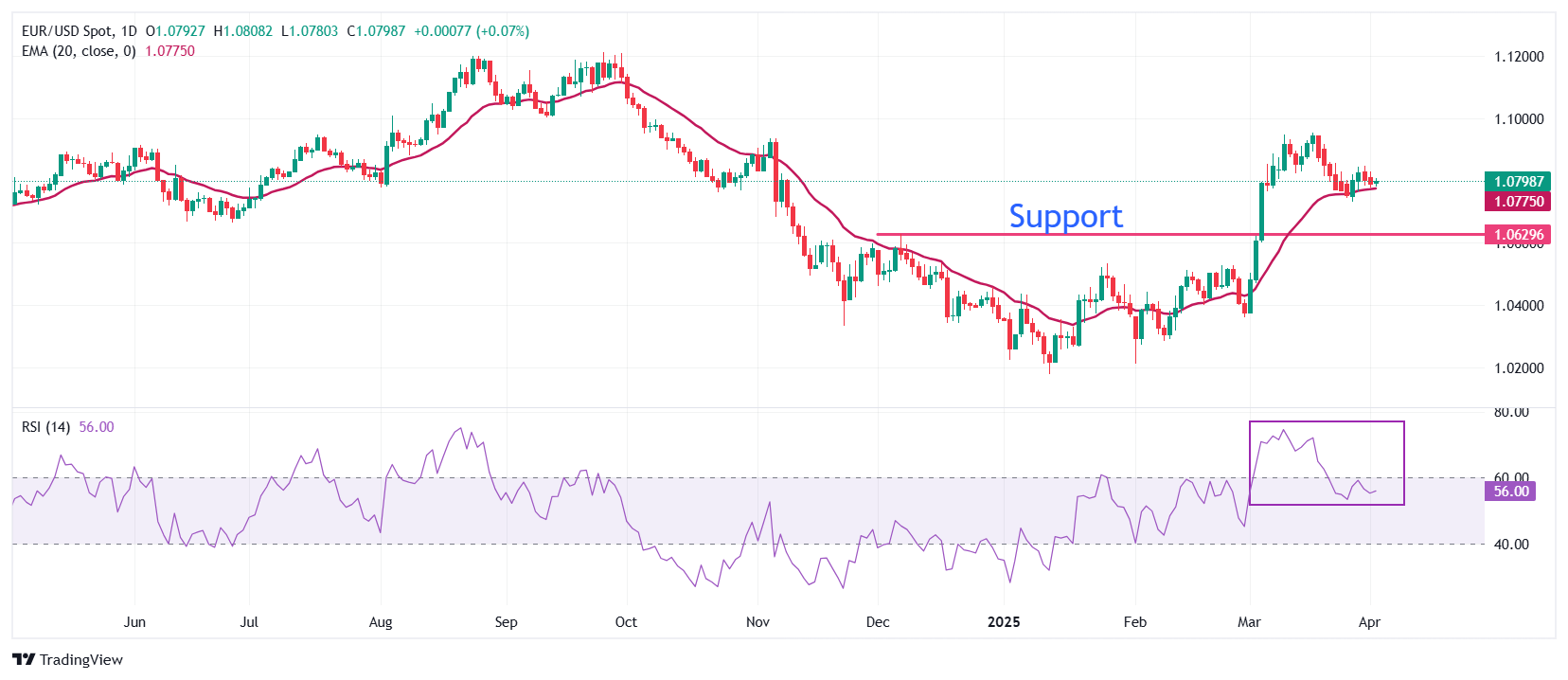提供最佳价差和条件
 了解更多
了解更多
EUR/USD wobbles around 1.0800 during European trading hours on Wednesday. The major currency pair struggles for direction as investors refrain from building fresh positions before the announcement of reciprocal tariffs by United States (US) President Donald Trump at 20:00 GMT.
US President Trump's fresh suite of tariffs is expected to become effective immediately after the announcement. Such a scenario will upend the global trading system, making products of countries that will attract higher tariffs less competitive. Higher import duties will also result in a slowdown in global business investment as firms would struggle to ascertain the demand outlook of their products.
The comments from US Treasury Secretary Scott Bessent on Tuesday also indicated that the President will impose the highest level of levies on his trading partners and stated that targeted countries could pass them by meeting US demands, specifically by diminishing rates on imports from the US.
Investors expect Trump's tariffs will also be unfavorable to the US economy, considering consumer and business confidence deterioration. The ISM Manufacturing Purchasing Managers Index (PMI) also showed on Tuesday that the business activity contracted in March after expanding for two straight months. "Demand and production retreated, and destaffing continued, as panellists’ companies responded to demand confusion," ISM Manufacturing Chair Timothy Fiore said.
Going forward, investors will also focus on the ADP Employment Change data for March, which will be published at 12:15 GMT. US private employers are expected to have added 105K fresh workers, higher than the 77K addition recorded in February.

EUR/USD oscillates inside Tuesday’s range, trading around 1.0800 at the time of writing on Wednesday. The 20-day Exponential Moving Average (EMA) continues to provide support to the pair around 1.0778.
The 14-day Relative Strength Index (RSI) cools down below 60.00, suggesting that the bullish momentum is over, but the upside bias is intact.
Looking down, the December 6 high of 1.0630 will act as the major support zone for the pair. Conversely, the psychological level of 1.1000 will be the key barrier for the Euro bulls.
The Euro is the currency for the 19 European Union countries that belong to the Eurozone. It is the second most heavily traded currency in the world behind the US Dollar. In 2022, it accounted for 31% of all foreign exchange transactions, with an average daily turnover of over $2.2 trillion a day. EUR/USD is the most heavily traded currency pair in the world, accounting for an estimated 30% off all transactions, followed by EUR/JPY (4%), EUR/GBP (3%) and EUR/AUD (2%).
The European Central Bank (ECB) in Frankfurt, Germany, is the reserve bank for the Eurozone. The ECB sets interest rates and manages monetary policy. The ECB’s primary mandate is to maintain price stability, which means either controlling inflation or stimulating growth. Its primary tool is the raising or lowering of interest rates. Relatively high interest rates – or the expectation of higher rates – will usually benefit the Euro and vice versa. The ECB Governing Council makes monetary policy decisions at meetings held eight times a year. Decisions are made by heads of the Eurozone national banks and six permanent members, including the President of the ECB, Christine Lagarde.
Eurozone inflation data, measured by the Harmonized Index of Consumer Prices (HICP), is an important econometric for the Euro. If inflation rises more than expected, especially if above the ECB’s 2% target, it obliges the ECB to raise interest rates to bring it back under control. Relatively high interest rates compared to its counterparts will usually benefit the Euro, as it makes the region more attractive as a place for global investors to park their money.
Data releases gauge the health of the economy and can impact on the Euro. Indicators such as GDP, Manufacturing and Services PMIs, employment, and consumer sentiment surveys can all influence the direction of the single currency. A strong economy is good for the Euro. Not only does it attract more foreign investment but it may encourage the ECB to put up interest rates, which will directly strengthen the Euro. Otherwise, if economic data is weak, the Euro is likely to fall. Economic data for the four largest economies in the euro area (Germany, France, Italy and Spain) are especially significant, as they account for 75% of the Eurozone’s economy.
Another significant data release for the Euro is the Trade Balance. This indicator measures the difference between what a country earns from its exports and what it spends on imports over a given period. If a country produces highly sought after exports then its currency will gain in value purely from the extra demand created from foreign buyers seeking to purchase these goods. Therefore, a positive net Trade Balance strengthens a currency and vice versa for a negative balance.